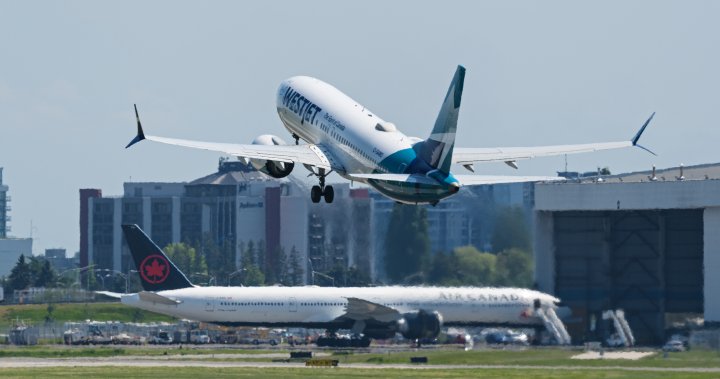Canada’s decision to ground Boeing’s 737 MAX-8 jets in 2019 came as a result of a chance European encounter that led to new data about two deadly crashes, suggest documents obtained by Global News.
Canada was one of the last countries to ground the Boeing-MAX 8 after an Ethiopian Airlines disaster on March 10, 2019, killed 157 people, including 18 Canadians.
The tragedy followed a similar disaster involving the MAX-8 five months earlier off the coast of Indonesia, killing 189 people.
After days of frantic behind-the-scenes activity at Transport Canada, Ottawa eventually banned the American-made jets from Canadian skies on March 13. But newly-released documents obtained through access to information laws show the decision to ground the MAX-8s came just hours before the announcement, the result of what appeared to be a coincidental meeting that provided new data showing similarities between the two crashes.
Nearly 800 pages of internal government documents – including emails, briefings and memos – offer a window into the flurried 72 hours that led then-Transport Minister Marc Garneau to his decision.
Several considerations were being weighed by senior Transport Canada officials, the documents show, including the impact of grounding the MAX-8 on Canadian airlines, the position of airline unions, and a general lack of evidence linking the Indonesian and Ethiopian crashes.
In a March 12 email – less than 24 hours before Garneau banned the MAX-8 from Canadian airspace – a senior Transport Canada official said that after the Ethiopian disaster, “our world-class experts found no reason to ground the fleet.”
“Need facts to act and we have no facts,” Aaron J. McCrorie, then in charge of safety and security at Transport Canada, wrote.
The facts would come nine hours later from an unlikely source.
According to the documents, two employees at NAV Canada – a non-profit corporation that runs Canada’s civil air navigation system – were attending a conference in Europe when they caught wind that the European Union grounded the MAX-8, based on data from a U.S.-based company called Aireon, which runs a global aircraft tracking surveillance system.
The email you need for the day’s
top news stories from Canada and around the world.
“Regarding how, when and to whom we got the satellite data… Nav Canada officials attending a conference in Europe realized that some of the data Aireon had could be of use to use,” wrote McCrorie in emails within the department explaining how the data came to light.
“Why did we only get that info yesterday morning? Simply that we did not know we could or would be provided the information. (This) is where Nav Canada (who was aware the information was available) played a key role in alerting us.”
The NAV Canada employees connected Aireon’s then-Vice President Cyriel Kronenburg with Transport Canada officials, who received the data around 6 a.m. Eastern on March 13.
“Attached you have the Ethiopian event and the Lion Air event … if you compare the two they have some similarities,” wrote François Collins, the director general of aircraft services at Transport Canada, in a 6:48 a.m. email.
Up to that point, Canadian officials did not believe there was evidence linking the two. Five hours later Garneau held a news conference and announced Canada was grounding the Boeing MAX-8 effective immediately.
Global News reported in February that the day before Garneau’s announcement, communications staff and senior officials at Transport Canada were working on three different speeches for the minister. One said that Transport Canada officials had found no reason to ban the MAX-8 from Canadian airspace. Another said that the aircraft would be permitted to enter and leave Canadian airports under certain conditions. The final speech – which Garneau ultimately gave on March 13 – grounded the MAX-8s immediately.
“My experts have looked at this (data) and compared it to the flight that occurred with Lion Air six months ago in October and there are — and I hasten to say — not conclusive, but there are similarities that sort of exceed a certain threshold in our mind,” he said at the time.
According to the documents, while Garneau and officials were making that decision, there were 16 MAX-8s flying into or out of Canadian airports. That included 13 operated by Air Canada, who told government officials that they were considering “voluntarily” grounding its fleet of Boeing jets before Garneau issued his order.
Ultimately, investigators found Ethiopian Airlines and Lion Air crashes were connected, after identifying problems with Boeing’s anti-stall software known as MCAS. Flaws in some of the aircraft sensors forced the nose of the MAX-8s down, while pilots fought to right the jets.
The two crashes signalled the start of a safety crisis at Boeing that persists today.
In 2019, Garneau said the U.S. Federal Aviation Administration (FAA) had his full confidence. The FAA certified the Boeing MAX-8 and Canada accepted that certification. But a month later, Garneau said Transport Canada was changing the approval process, and would certify Boeing’s software fixes itself.
In 2021, after almost two years of grounding, Canada cleared the MAX-8 to fly again.
That same year, Boeing admitted to misleading American regulators and agreed to pay US$2.5 billion to settle with the U.S. Justice Department. The fine included compensation to the families of the Ethiopian Airlines crash victims.
But on Jan. 5, 2024, safety concerns over Boeing jets were sparked again, this time with the MAX-9 jet. The panel blew off an Alaska Airlines flight over Oregon, causing an emergency landing. No one was seriously injured.
Last March, a longtime Boeing employee who blew the whistle on the planemaker’s alleged lax safety standards was found dead in his car in South Carolina. The Charleston County Coroner’s Office told local media it appears he died from a self-inflicted wound.
Earlier this month, another Boeing employee told U.S. senators the company took shortcuts in a rush to produce as many 787 Dreamliners as possible.
“They are putting out defective airplanes,” the Boeing engineer, Sam Salehpour, told a Senate subcommittee.
The company says claims about the Dreamliner’s structural integrity are false.
Global News requested comment from Aireon, the company that provided the data to the Canadian government. A spokesperson said that Kronenburg no longer works with the company, and suggested reaching out to Transport Canada.
Global sent a list of questions to Transport Canada, including why the department didn’t proactively seek out the data, whether the department was aware such data existed, and whether or not the department has taken steps to access similar data more quickly in the event of future air disasters.
In a statement, the department did not address those questions. Instead, a Transport Canada spokesperson noted that the U.S. FAA “is the responsible civil aviation authority” for the Boeing jets involved in the crashes.
“Transport Canada continues to work closely with bilateral partners to ensure that the level of cooperation and sharing is in line with our mutual safety objectives,” the spokesperson wrote.




